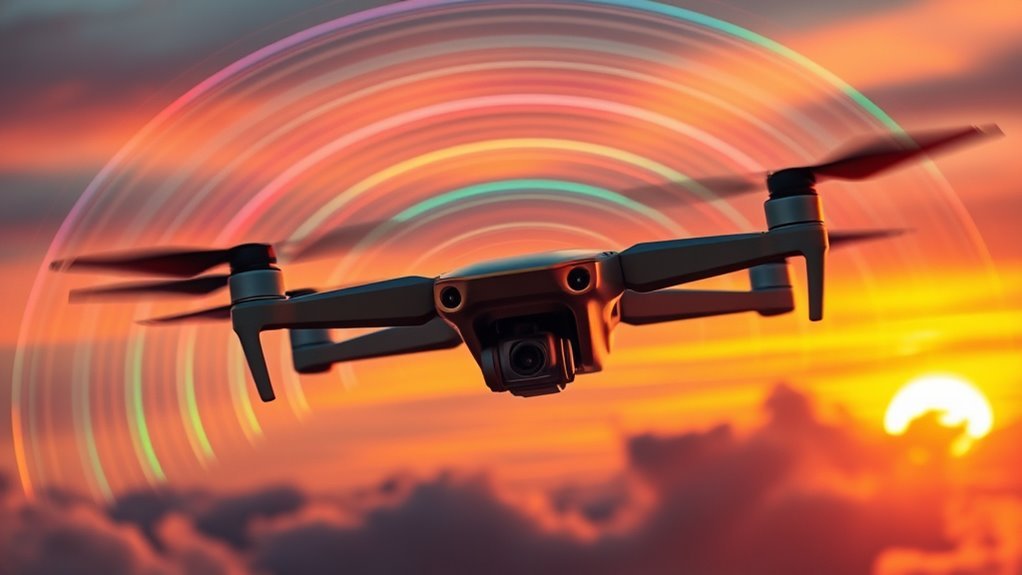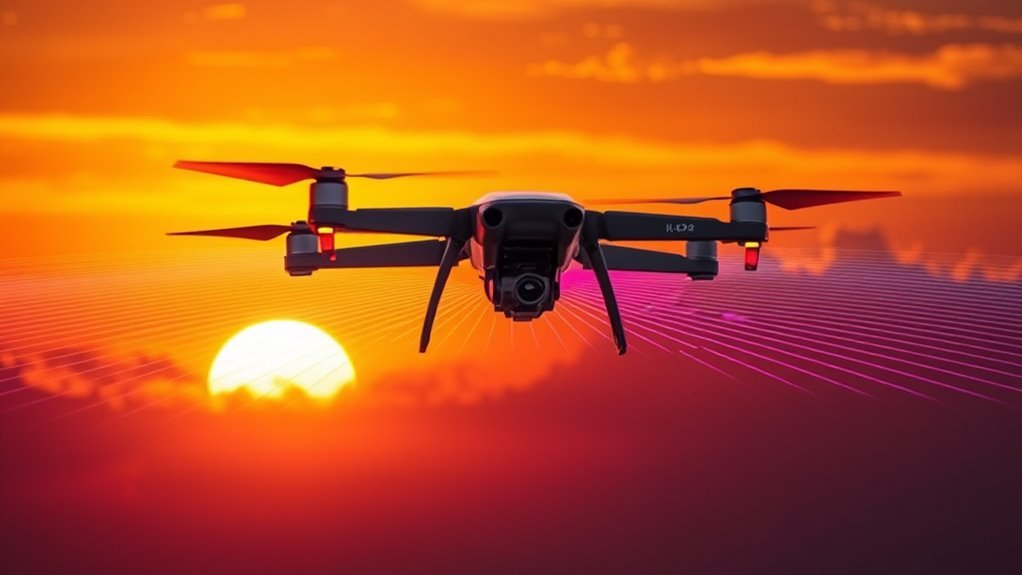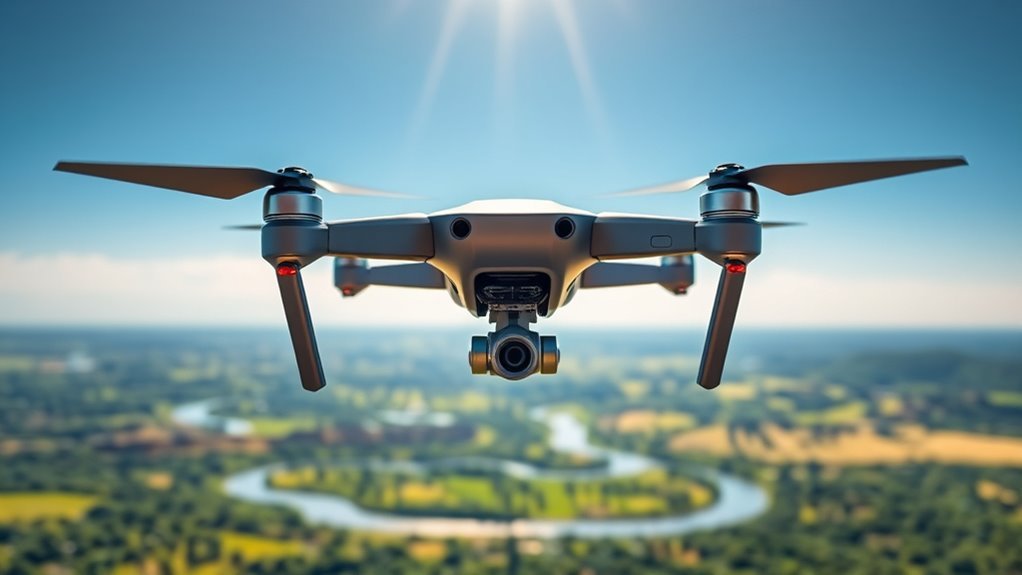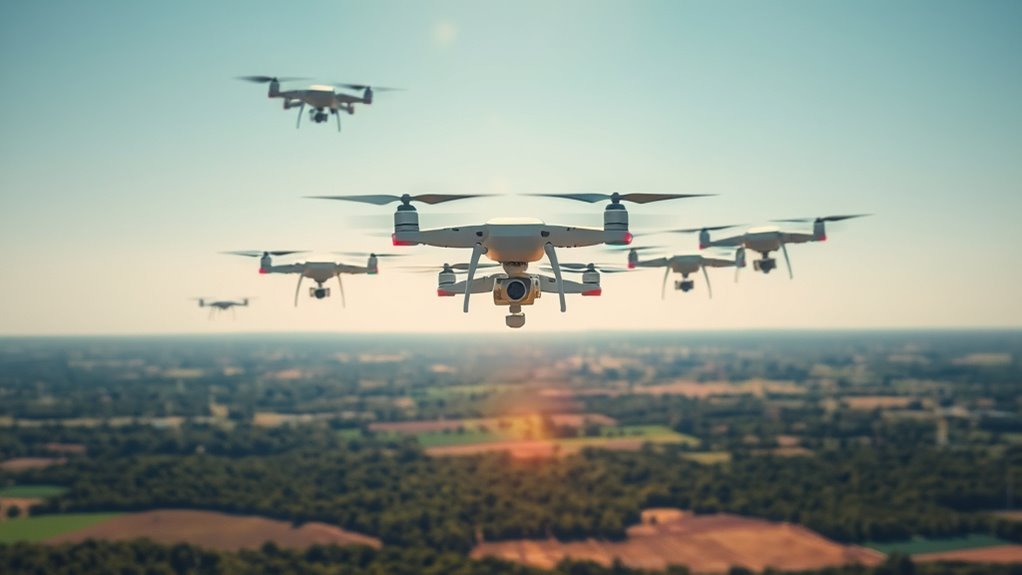You’ll find drones operating mostly in the 2.4 GHz and 5.8 GHz bands, with 2.4 GHz commonly handling control signals and 5.8 GHz used for video transmission. Some drones use 900 MHz or 1.2 GHz frequencies to extend range and improve obstacle penetration. These frequencies balance range, data rate, and interference resilience, all regulated to guarantee legal operation. Exploring these choices reveals how they impact performance, reliability, and mission success.
Overview of Drone Communication Systems

Although drone technology has rapidly advanced, effective communication systems remain fundamental to their operation, ensuring control, data transmission, and safety. When you engage with drone networking, you rely on robust links that enable real-time command and telemetry exchange. These systems must minimize signal interference, which can degrade control precision and compromise operational freedom. You’ll find that drone communication protocols employ frequency hopping and adaptive power control to mitigate interference risks, maintaining stable connections even in congested environments. Understanding these dynamics is essential if you want your drone to operate reliably without restrictions. By focusing on interference-resistant networking strategies, you maintain the freedom to explore complex airspaces confidently, knowing your drone’s communication integrity supports uninterrupted, secure control and data flow.
Common Radio Frequency Bands for Consumer Drones

To maintain reliable control and data exchange, consumer drones primarily operate within specific radio frequency bands regulated for minimal interference and ideal range. Understanding these 2. consumer drone bands helps you optimize flight performance and maintain legal compliance. The most common frequencies include:
Consumer drones use specific radio frequency bands to ensure reliable control, optimal range, and minimal interference.
- 2.4 GHz Band – Widely used for control signals, offering a balance of range and penetration.
- 5.8 GHz Band – Preferred for video transmission due to higher data rates but with shorter range.
- 900 MHz Band – Less common but useful for extended range and better obstacle penetration.
- 1.2 GHz Band – Occasionally used for video, providing moderate range and penetration capabilities.
These common frequencies guarantee you maintain robust connections while enjoying the freedom to explore without interference constraints.
Frequency Bands Used in Professional and Commercial Drones

When operating professional and commercial drones, you’ll encounter frequency bands that prioritize extended range, enhanced data throughput, and regulatory compliance specific to industrial applications. These drones typically utilize licensed frequency allocations within the 1.2 GHz, 2.4 GHz, and 5.8 GHz bands, with some systems incorporating LTE and even millimeter-wave frequencies for specialized tasks. The frequency allocation is carefully managed to minimize signal interference, ensuring reliable command and control links in congested environments. You’ll notice that commercial drone operations demand robust, interference-resistant communication protocols, often employing frequency hopping or spread spectrum techniques. By selecting appropriate frequency bands aligned with regulatory standards, you maintain operational freedom while avoiding disruptions. Understanding these allocations empowers you to optimize drone connectivity for mission-critical workflows without compromising signal integrity or compliance.
Impact of Frequency Choices on Drone Performance
Since frequency choices directly influence signal propagation characteristics, you’ll find that selecting the appropriate band is critical for optimizing drone performance parameters such as range, latency, and data throughput. Your drone’s operational efficiency hinges on managing signal interference and overcoming range limitations inherent to each frequency band. For effective performance optimization, consider these aspects:
Choosing the right frequency band is key to enhancing your drone’s range, latency, and data throughput.
- Frequency stability guarantees consistent data transmission without unexpected drops.
- Lower frequencies generally offer extended range but are more prone to interference.
- Higher frequencies support greater data throughput but suffer from shorter effective range.
- Balancing bandwidth availability and environmental factors minimizes latency and maximizes control responsiveness.
Regulatory Considerations for Drone Radio Frequencies
Although selecting the ideal radio frequency band is vital for drone performance, you must also navigate complex regulatory frameworks that govern frequency allocation and usage. Regulatory compliance guarantees your drone operates within legally designated bands, preventing interference with critical communications and avoiding penalties. Frequency allocation varies by country, often managed by national telecommunications authorities, which designate specific bands for unlicensed drone operation, such as 2.4 GHz and 5.8 GHz ISM bands. Understanding these allocations allows you to maximize operational freedom while maintaining legal adherence. Ignoring these regulations risks disruption, legal sanctions, and loss of control authority. As a result, balancing your desire for operational flexibility with strict regulatory compliance is essential for sustainable drone use, providing both freedom in flight and adherence to the technical confines of frequency management.
Future Trends in Drone Frequency Technology
You’ll need to monitor emerging frequency technologies like terahertz bands and dynamic spectrum access that promise increased bandwidth and reduced interference. Regulatory bodies are also shifting spectrum allocations to accommodate drone traffic more efficiently. Understanding these changes will be critical for optimizing your drone’s communication systems in the near future.
Emerging Frequency Technologies
As drone technology advances, emerging frequency technologies are poised to redefine communication capabilities by enhancing bandwidth efficiency, reducing latency, and improving resistance to interference. You’ll find these frequency innovations critical for expanding drone operational freedom and reliability. Key emerging technologies include:
- Terahertz Band Utilization – Offers ultra-high data rates with minimal congestion.
- Cognitive Radio Systems – Dynamically adapt frequencies to avoid interference.
- Millimeter Wave (mmWave) Communication – Provides high-capacity links for short-range control.
- Massive MIMO (Multiple Input Multiple Output) – Increases spectral efficiency by leveraging multiple antennas.
Spectrum Regulation Changes
Since drone applications are rapidly evolving, spectrum regulation must adapt to accommodate new frequency demands and mitigate interference risks. You’ll encounter increasing regulatory challenges as spectrum allocation becomes more complex, balancing the needs of commercial, recreational, and governmental drone operations. Authorities are reconsidering rigid band assignments to enable dynamic spectrum access, giving you greater operational flexibility while ensuring coexistence with existing wireless services. This shift aims to minimize bottlenecks and reduce the risk of signal interference. By staying informed on regulatory updates, you can leverage emerging frameworks that promote efficient spectrum use without compromising freedom of movement. Understanding these evolving spectrum allocation policies will empower you to operate drones more effectively in an increasingly crowded radio frequency environment.

